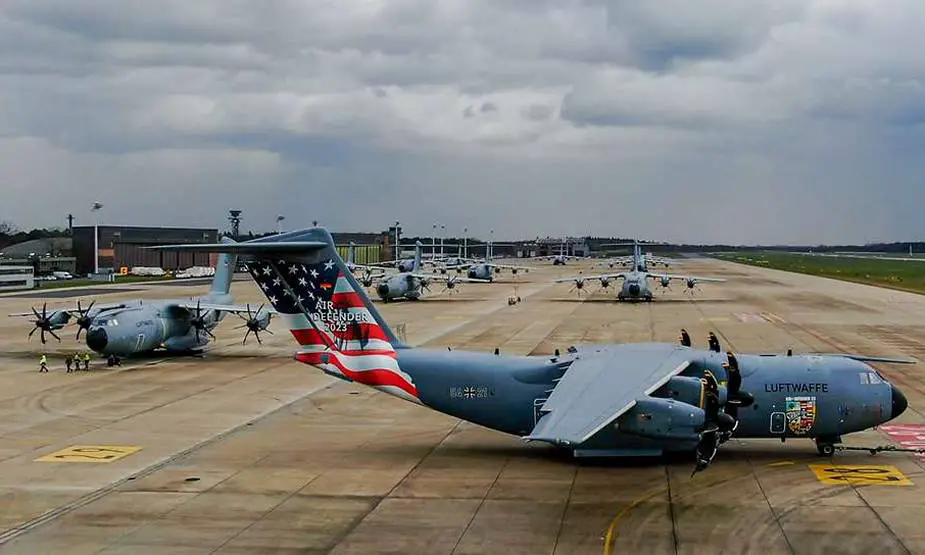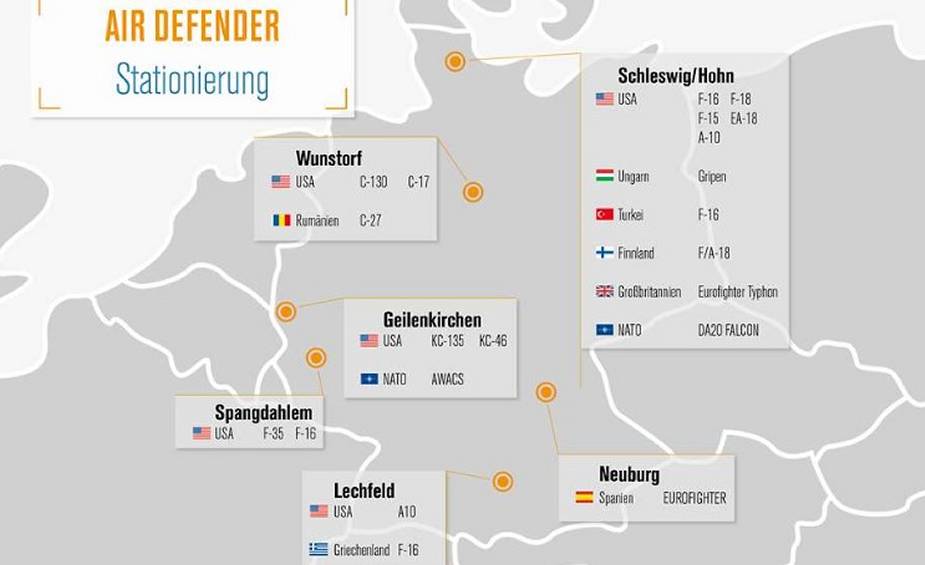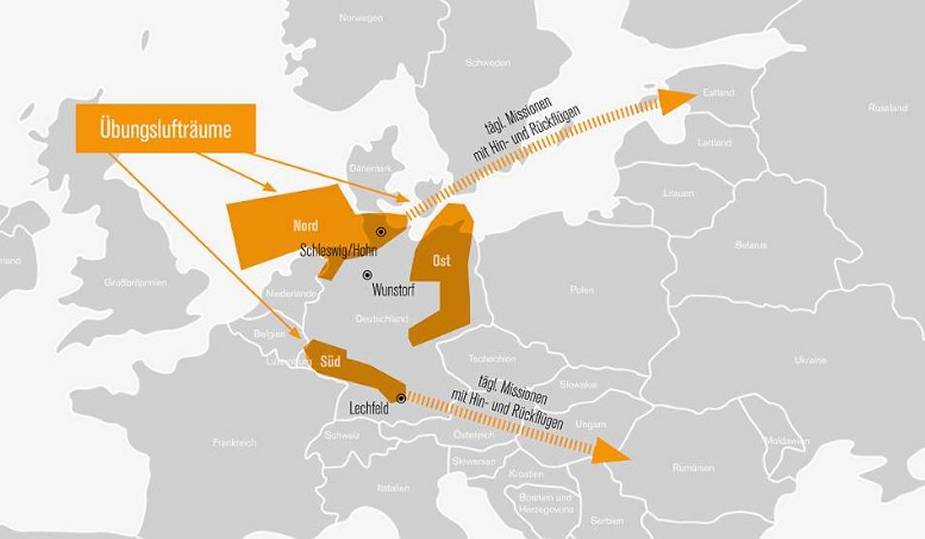Breaking news
NATO launches Air Defender 23 as largest air exercise of its history.
In the multinational Air Defender 23 exercise, 25 nations come together to train in joint air operations in the skies above Europe. From June 12 to 23, up to 10,000 participants from 25 nations, along with 250 aircraft, will engage in air training exercises in European airspace, under the leadership of the German Air Force. NATO initiates its largest aerial maneuvers exercise, coordinated by Germany, with the aim of demonstrating the unity of its members in the face of potential threats, particularly from Russia.
Follow Air Recognition on Google News at this link
 Among the 250 aircraft involved are 23 different types of aircraft. 100 of these aircraft alone come from 42 United States federal states and are being deployed to Europe. The U.S. Air National Guard provides the very largest portion of these (Picture source: Bundeswehr/Johannes Heyn)
Among the 250 aircraft involved are 23 different types of aircraft. 100 of these aircraft alone come from 42 United States federal states and are being deployed to Europe. The U.S. Air National Guard provides the very largest portion of these (Picture source: Bundeswehr/Johannes Heyn)
From June 12-23, up to 10.000 exercise participants from 25 nations with 250 aircraft will train air operations in European airspace under the command of the German Air Force. 25 nations and NATO exercise the joint response capability of their air forces in a crisis situation. Germany is taking the lead role and is the logistical hub.
The following nations are participating: Belgium, Bulgaria, Croatia, Czech Republic, Denmark, Estonia, Finland, France, Germany, Greece, Hungary, Italy, Japan, Latvia, Lithuania, Netherlands, Norway, Poland, Romania, Slovenia, Spain, Sweden, Turkey, United Kingdom, United States. Aircraft from partner nations will be stationed at several locations in Germany during the exercise.
About 10,000 servicemen and women are taking part in the exercise. Among the 250 aircraft involved are 23 different types of aircraft. 100 of these aircraft alone come from 42 United States federal states and are being deployed to Europe. The U.S. Air National Guard provides the very largest portion of these.
 Aircraft from partner nations will be stationed at Wunstorf, Schleswig/Hohn, Geilenkirchen, Spangdahlem, Lechfeld and Neuburg (Picture source: Bundeswehr/Marco Parge)
Aircraft from partner nations will be stationed at Wunstorf, Schleswig/Hohn, Geilenkirchen, Spangdahlem, Lechfeld and Neuburg (Picture source: Bundeswehr/Marco Parge)
The three main hubs during Air Defender 23 are Schleswig/Hohn, Wunstorf and Lechfeld. The exercises will be conducted mainly in three airspaces over Germany. The exercise areas are based on areas that have been used by the Air Force for routine training for decades. However, they have been expanded for Air Defender 23 and are partly connected by corridors.
Flight altitudes during Air Defender in the three training areas range from 2,500 to 15,000 meters and higher. No missions are usually flown below that. Refueling generally takes place at altitudes ranging from 3,000 to 10,000 meters. Jet-fight training flights take place at altitudes of 2,500 or 3,000 meters, depending on the airspace activated. Low-level flights by jets and transport aircraft are planned in a part of the eastern air exercise area known as Fight 1. This training area extends over northern Brandenburg, parts of Mecklenburg-Western Pomerania, and the Baltic Sea. The airspace is reserved for these low-level flights for three hours at a time every day from June 12 to 22. In addition, sporadic low-level flights will take place at the Baumholder and Grafenwoehr military training areas.
 The U.S. Air National Guard is moving 100 aircraft to Europe. There, a total of 25 nations exercise joint air operations in three airspaces over Germany at Air Defender 23 (Picture source: Bundeswehr/Marco Parge)
The U.S. Air National Guard is moving 100 aircraft to Europe. There, a total of 25 nations exercise joint air operations in three airspaces over Germany at Air Defender 23 (Picture source: Bundeswehr/Marco Parge)
The exercise was designed in 2018, partly in response to Russia's annexation of Crimea in 2014, even though it does not specifically target anyone, explained General Ingo Gerhartz, Chief of the German Air Force, during the exercise presentation.
NATO is determined to defend "every inch" of its territory, but "no flights will be sent, for example, towards Kaliningrad," the Russian enclave bordering Poland and Lithuania, NATO members, assured General Gerhartz. "We are a defensive alliance, and that's how this exercise is planned," the general emphasized. However, these maneuvers will also aim to send a message, particularly to Russia, as explained to the press by the US Ambassador to Germany, Amy Gutmann: "I would be very surprised if a world leader did not take note of what it shows in terms of the spirit of this alliance, what the strength of this alliance means, and that includes Mr. Putin," the Russian President, she argued.
The exercise will involve operational and tactical training, mainly in Germany, but also in the Czech Republic, Estonia, and Latvia. The exercise aims to "supplement the permanent presence of the United States in Europe" and provide training "on a larger scale than is usually accomplished on the continent," said General Michael Loh, Director of the US Air National Guard. "It is about establishing what it means to confront a major power in the context of competition between major powers." There are no plans at this stage to make "Air Defender" a regular exercise, Ms. Gutmann said. But, she added, "we do not want this exercise to be the last."


























